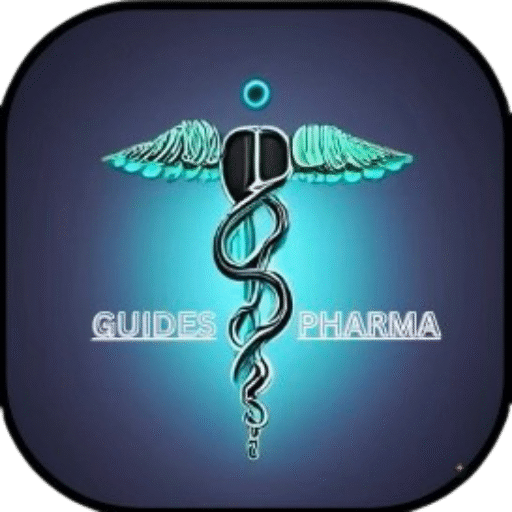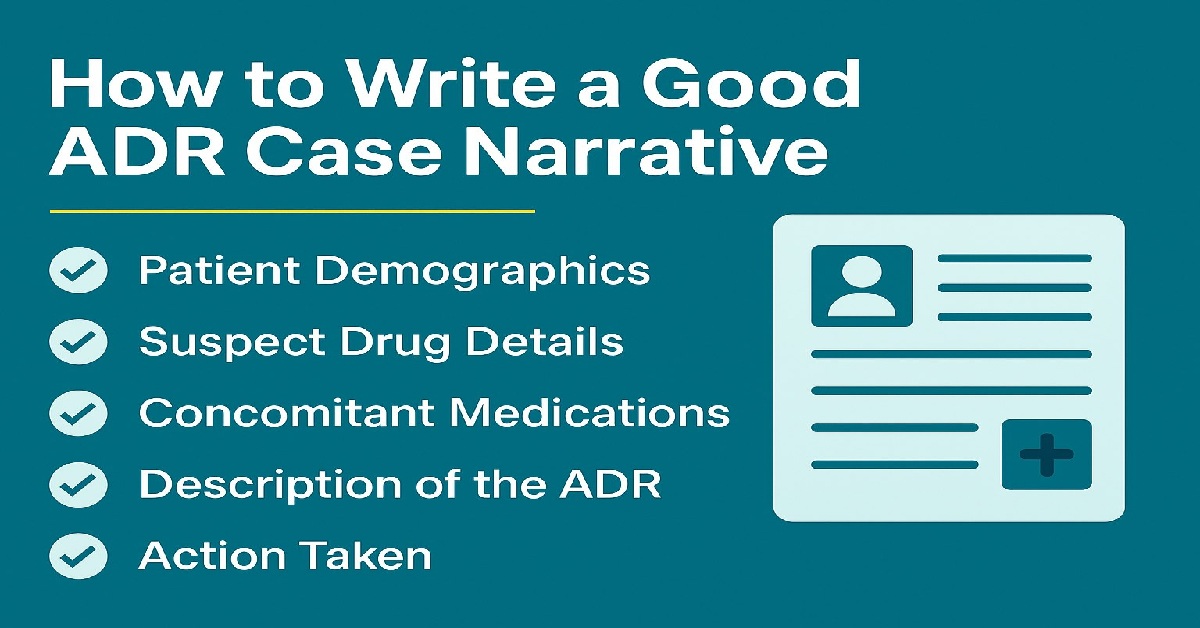Table of Contents
ToggleIntroduction
In the world of pharmacovigilance, ADR case narrative writing is more than just documentation — it’s the art of telling a patient’s medical story in a way that ensures clarity, accuracy, and compliance. Narratives form a core part of Individual Case Safety Reports (ICSRs) and are used by global regulatory agencies to assess the safety of pharmaceutical products.
Whether you’re a beginner in pharmacovigilance or a healthcare professional aiming to improve your narrative writing skills, this article will walk you through the structure, offer useful tips, and provide a sample narrative to get you started.
What is an ADR Case Narrative?
An ADR (Adverse Drug Reaction) case narrative is a detailed written summary of a reported adverse event. It describes the timeline of drug administration, adverse reactions, patient history, treatments, and outcomes in a chronological and medically relevant manner.
Narratives are typically required for:
- Serious adverse events (SAEs)
- Fatal or life-threatening reactions
- Unexpected reactions (not mentioned in the product label)
- Regulatory submissions like PSURs, DSURs, and PADERs
Why is ADR Case Narrative Writing Important?
A well-written narrative is critical for:
- Regulatory decision-making
Agencies like the US FDA, EMA, and CDSCO use narratives to evaluate if an adverse reaction warrants a change in drug safety information. - Signal detection
Case narratives help identify patterns of rare or serious ADRs. - Pharmacovigilance compliance
Poorly written or missing narratives can lead to regulatory non-compliance, delays in approval, or rejection of cases.
Structure of a Good ADR Case Narrative
Here’s the standard format used by global pharmaceutical companies and CROs:
- Patient Demographics
- Age, gender, weight, and height (if available)
- Relevant medical history and risk factors
- Suspect Drug Information
- Brand/generic name
- Dosage form, strength, route of administration
- Dose, frequency, indication, start/stop date
- If drug was withdrawn or continued during the event
- Concomitant Medications
- Include all non-suspect medications
- Mention only relevant ones with possible interaction or overlapping effects
- Description of the Adverse Event
- Date and time of onset
- Symptoms, clinical signs, diagnosis (if available)
- Duration and severity of the event
- Any lab tests or diagnostic procedures
- Medical Management & Outcome
- Treatment given for the reaction
- Hospitalization or emergency procedures
- Patient’s recovery or outcome (recovered/resolved, ongoing, fatal)
- Causality & Dechallenge/Rechallenge
- Was the drug withdrawn? Did symptoms improve?
- Was the drug reintroduced? Did symptoms recur?
- Medical Review (Optional)
- Summary of medical judgment by physician or case processor
Professional Tips for Effective ADR Case Narrative Writing
✅ 1. Stick to Chronology
Maintain a clear sequence of events. The reader (regulator or reviewer) should be able to follow the timeline easily.
✅ 2. Use Clear, Clinical Language
Avoid lay terms. Use appropriate medical terminology and MedDRA terms when possible.
✅ 3. Be Objective and Factual
Do not assume or diagnose unless confirmed. Stick to facts presented by the reporter or available in the case record.
✅ 4. Eliminate Redundancy
Avoid copying structured data like lab values or medication dates directly from forms. Integrate them into the flow logically.
✅ 5. Follow the Past Tense and Third Person Rule
Use phrases like:
“The patient experienced…”
“The suspect drug was discontinued on…”
✅ 6. Avoid Personal Bias
Do not include opinions unless stated by a qualified healthcare professional. If the causality assessment is done by the physician, mention that clearly.
Sample ADR Case Narrative
A 56-year-old male patient with a medical history of type 2 diabetes mellitus and hypertension was prescribed Metformin 500 mg twice daily starting 10 May 2024 for glycemic control. On 12 May 2024, the patient developed symptoms of nausea, vomiting, and abdominal discomfort. There was no history of alcohol intake or recent change in diet. The patient was also taking Amlodipine 5 mg once daily for blood pressure management, initiated 6 months prior.
Upon evaluation, the treating physician suspected Metformin-induced gastrointestinal intolerance. Metformin was discontinued on 14 May 2024, and the patient was advised to maintain hydration and was prescribed domperidone and pantoprazole. The symptoms resolved completely by 18 May 2024.
The adverse reaction was assessed as non-serious and possibly related to Metformin due to the temporal relationship and resolution upon withdrawal. No rechallenge was attempted. The outcome of the adverse event was reported as recovered.
Regulatory Requirements for Narratives
Different authorities have specific requirements:
- EMA (Europe): Requires narratives for all serious cases submitted in E2B format and PSURs.
- FDA (USA): Requires clear and medically sound narratives in IND safety reports and annual reports.
- CDSCO (India): Requires detailed narratives in SAE forms (Form 11) for clinical trials.
- CDSCO Pharmacovigilance Guidelines Simplified:
Understand India’s regulatory expectations for adverse drug reaction (ADR) reporting, risk management plans, and signal detection—use this guide to meet CDSCO requirements confidently and improve patient safety.
Failing to meet these standards may result in queries, data rejection, or regulatory penalties.
Common Mistakes to Avoid
| Mistake | Why It’s a Problem |
| Copying structured data directly | Reduces readability |
| Vague timelines | Confuses regulatory reviewers |
| Overusing abbreviations | Causes misinterpretation |
| Missing drug start/stop dates | Weakens causality assessment |
| Ignoring lab/test data | Makes narrative incomplete |
Final Thoughts
ADR case narrative writing is a critical skill in pharmacovigilance. Whether you’re writing your first narrative or trying to improve case quality, mastering the structure, tone, and content is key to ensuring safety data is properly communicated to regulators.
Take your time to understand the case, maintain objectivity, and follow the chronological flow. With practice and attention to detail, your narratives will become more impactful and regulation-compliant.
📚 Topics Covered in This Guide:
- ADR case narrative writing
- Sample pharmacovigilance narrative
- How to write an ADR narrative
- Drug safety case writing techniques
- PV narrative format and structure
- ICSR narrative examples
❓Frequently Asked Questions (FAQs)
- What is an ADR case narrative?
An ADR case narrative is a written summary of a reported adverse drug reaction, describing the patient’s history, drug exposure, adverse event details, treatment, and outcome in a logical, clinical format.
- Who writes ADR narratives?
ADR narratives are typically written by pharmacovigilance professionals, such as case processors, medical reviewers, or drug safety associates working in pharmaceutical companies or CROs.
- What is the ideal length of an ADR narrative?
There is no fixed word count, but most ADR narratives range between 150–300 words, depending on the complexity of the case and seriousness of the event.
- How is causality assessed in a narrative?
Causality is assessed based on the temporal relationship between the drug and reaction, dechallenge/rechallenge results, and absence of alternative causes. The assessment is often supported by a physician’s or medical reviewer’s opinion.
- Are ADR narratives required for all ICSRs?
Narratives are mandatory for serious cases, fatal or life-threatening events, unlisted reactions, and clinical trial SAEs. They may not be needed for non-serious, well-documented spontaneous reports.
- Can I use templates for ADR case narrative writing?
Yes. Using a standardized template helps ensure completeness and consistency. However, narratives should still be tailored to the clinical facts of each case.
- What’s the difference between ICSR and ADR narrative?
An ICSR is the full safety case report that includes patient details, drug info, lab results, and structured fields. The ADR narrative is the free-text summary written within the ICSR to describe the clinical sequence.
- Is there a regulatory guideline for narrative writing?
Yes, regulatory bodies like the EMA, FDA, and CDSCO provide expectations for narrative content in ICH E2E, GVP modules, and SAE reporting forms.

